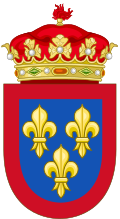| Duke of Seville | |
|---|---|
 | |
| Creation date | 23 April 1823 |
| Created by | Ferdinand VII |
| First holder | Infante Enrique |
| Present holder | Olivia de Borbón y von Hardenberg-Fürstenberg |
| Heir apparent | Flavia Porras-Figueroa y de Borbón |
| Remainder to | heirs of the body of the grantee according to absolute primogeniture |
| Subsidiary titles | Marquess of Amarillas |
| Status | Extant |

Duke of Seville (Spanish : Duque de Sevilla) is a hereditary title of Spanish nobility, accompanied by the dignity of Grandee. It was granted in 1823 by King Ferdinand VII to his nephew, Infante Enrique. The dukes of Seville are members of the Spanish branch of the House of Bourbon.
Contents
From 22 October 1968 until his death on 20 May 2025, the holder of the ducal title was Don Francisco de Borbón y Escasany, 5th Duke of Seville. [1]